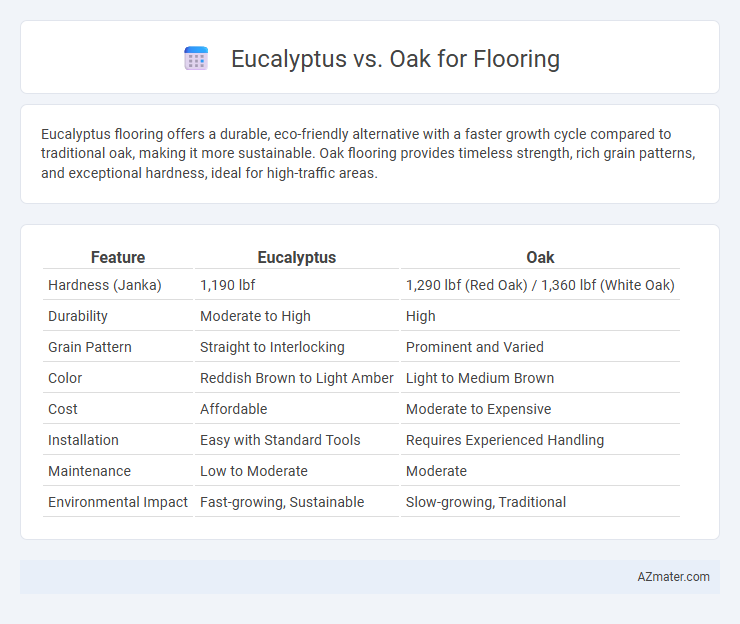Eucalyptus flooring offers a durable, eco-friendly alternative with a faster growth cycle compared to traditional oak, making it more sustainable. Oak flooring provides timeless strength, rich grain patterns, and exceptional hardness, ideal for high-traffic areas.
Table of Comparison
| Feature | Eucalyptus | Oak |
|---|---|---|
| Hardness (Janka) | 1,190 lbf | 1,290 lbf (Red Oak) / 1,360 lbf (White Oak) |
| Durability | Moderate to High | High |
| Grain Pattern | Straight to Interlocking | Prominent and Varied |
| Color | Reddish Brown to Light Amber | Light to Medium Brown |
| Cost | Affordable | Moderate to Expensive |
| Installation | Easy with Standard Tools | Requires Experienced Handling |
| Maintenance | Low to Moderate | Moderate |
| Environmental Impact | Fast-growing, Sustainable | Slow-growing, Traditional |
Introduction: Eucalyptus vs Oak Flooring
Eucalyptus flooring offers a sustainable and fast-growing hardwood alternative with natural resistance to moisture and insects, making it ideal for humid environments. Oak flooring, known for its durability and classic aesthetic, provides a timeless appeal with distinct grain patterns and strong wear resistance suitable for high-traffic areas. Both options deliver hardness and beauty, but eucalyptus flooring tends to be more affordable and eco-friendly compared to traditional oak.
Wood Species Overview: Eucalyptus and Oak
Eucalyptus wood is a fast-growing, sustainable hardwood known for its durability and rich reddish-brown hues, making it a popular choice for eco-friendly flooring. Oak, a classic hardwood species, offers exceptional hardness, distinctive grain patterns, and a wide range of natural color variations from light tan to deep brown, contributing to its timeless appeal in flooring applications. Both species provide strong resistance to wear, but Eucalyptus tends to have a higher density, which enhances its impact resistance and longevity in high-traffic areas.
Durability Comparison: Eucalyptus vs Oak
Eucalyptus flooring offers high durability due to its dense hardwood structure, resisting scratches and dents effectively, making it suitable for high-traffic areas. Oak flooring, especially white oak, is renowned for its exceptional hardness and long-lasting resilience, often rated higher on the Janka hardness scale compared to eucalyptus. Both woods provide durable options for flooring, but oak generally outperforms eucalyptus in terms of lifespan and resistance to wear.
Appearance and Color Variations
Eucalyptus flooring showcases a rich, warm reddish-brown hue with subtle streaks, offering a contemporary and vibrant aesthetic. Oak flooring, available in both red and white varieties, displays natural color variation from light beige to medium brown with prominent grain patterns that add character and timeless appeal. The distinct color variations in oak provide versatile design options, while eucalyptus offers a more uniform yet striking appearance for modern interiors.
Environmental Impact and Sustainability
Eucalyptus flooring offers a rapidly renewable resource with fast growth rates, making it a more sustainable choice compared to oak, which typically requires decades to mature. The carbon sequestration capabilities of eucalyptus contribute to lower environmental impact through efficient CO2 absorption during its growth cycle. Oak, while durable, often involves more intensive logging practices and longer forest regeneration times, increasing its ecological footprint relative to eucalyptus.
Cost Differences: Eucalyptus vs Oak
Eucalyptus flooring generally offers a more budget-friendly option compared to oak, with prices typically ranging between $3 to $7 per square foot, while oak flooring costs usually fall between $5 to $10 per square foot. The lower cost of eucalyptus is attributed to its faster growth rate and abundance, making it an economical choice for large-scale installations. Oak's higher price reflects its durability, classic aesthetic, and longer maturation period, contributing to its premium market value.
Installation Process and Challenges
Eucalyptus flooring offers a faster installation process due to its engineered plank design, which often features click-lock systems, making it suitable for DIY projects and reducing labor costs. In contrast, oak flooring typically requires traditional nail-down or glue-down methods, demanding more skilled labor and longer installation times. Challenges with eucalyptus include moisture sensitivity that may require acclimation and moisture barriers, while oak's hardness can complicate cutting and fitting but provides superior durability and longevity.
Maintenance and Longevity
Eucalyptus flooring offers durability with moderate maintenance, requiring regular sealing and cleaning to prevent moisture damage and maintain its rich color, while oak flooring provides excellent longevity due to its dense grain and resistance to wear, needing less frequent refinishing. Both woods can last several decades with proper care, but oak's natural hardness often leads to better performance in high-traffic areas. Choosing between eucalyptus and oak depends on balancing maintenance routines with desired lifespan and aesthetic preferences.
Pros and Cons of Eucalyptus and Oak Flooring
Eucalyptus flooring is known for its rapid renewability, hardness, and rich, warm hues that resist dents and scratches, making it a sustainable and durable choice; however, it can be prone to moisture damage and may require more maintenance in humid environments. Oak flooring offers timeless beauty, exceptional strength, and excellent resistance to wear, with the added benefit of a vast range of finishes and stains, but is generally more expensive and can be susceptible to fading from prolonged sunlight exposure. Both options provide long-lasting floors with unique grain patterns, but eucalyptus stands out for eco-friendliness while oak is favored for its classic appearance and versatility.
Best Applications and Recommendations
Eucalyptus flooring is ideal for high-traffic areas due to its durability, resistance to moisture, and eco-friendly nature, making it suitable for kitchens and living rooms. Oak, known for its classic appearance and hardness, excels in formal spaces like dining rooms and hallways, offering timeless elegance and long-lasting performance. For a blend of sustainability and strength, eucalyptus floors suit modern, casual environments, while oak remains the preferred choice for traditional, high-end interiors.

Infographic: Eucalyptus vs Oak for Flooring
 azmater.com
azmater.com